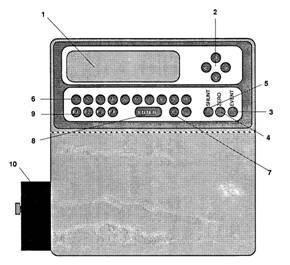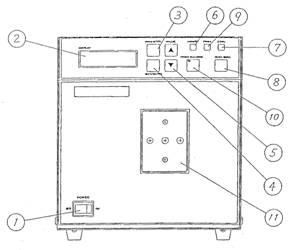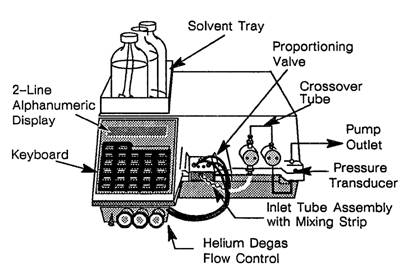Chrompack Grass
| Objektnummer | B00011686 |
|---|---|
| Numéro d'identification | 011686 |
| Nom de l'objet | Chrompack Grass |
| Statut | Stock unit |
Groupe de produits: Systèmes CLHP
Statut, conditions de livraison et de paiement
Vérification des appareils
Les appareils d’occasion sont vérifiés par Labexchange Service GmbH avant la livraison. Vous recevez des appareils entièrement fonctionnels.
Délai d'expédition
Les délais de livraison indiqués sont les plus rapides pour l’article en cause. Les délais de fait peuvent varier au cas par cas. Les délais de livraison définitifs sont indiqués dans la confirmation de commande.
Nous offrons des livraisons collectives par principe. Le délai de livraison s’oriente à l’article avec le délai de livraison le plus long. Une livraison partielle est possible par prix additionnel.
Méthodes d'expédition
Courrier, agences d'expédition, autocueillette, livraison par flotte de Labexchange
Conditions de livraison
Prix plus frais d’expédition. Les frais d’expédition indiqués sont à prévoir. Dérogations éventuelles sont possibles.
Si les coûts de transport ne sont pas spécifiés, s'il vous plaît demander séparément les frais de transport. Les frais de transport et d'emballage indiqués se réfèrent à l'itinéraire de transport le moins cher et sont sujets à des augmentations de coûts imprévues. En raison d'événements imprévisibles, les tarifs de transport et les délais de livraison peuvent changer à tout moment et doivent être adaptés à la situation actuelle. Incoterm codage selon les Incoterms 2010: Pour personnes qui viennent chercher les dispositifs elles-mêmes: EXW, pour les expéditions par voie maritime: CFR, par avion: CPT, d'autres expéditions: DAP. Remarque: Nous n'établissons pas des preuves préférentielles/EUR1. Dans le cas d’un enlèvement par vos soins/EXW de pays à l’intérieur ou à l’extérieur de la Union européenne, nous devons conserver 16% de TVA d’acheteur comme dépôt de garantie, jusqu’à ce que nous ayons reçu l’attestation de reception/la prevue de livraison.
Modalités de paiement
Nous n’acceptons pas le paiement par lettre de credit, PayPal, etc. Dans tous les cas le montant est payable sans déduction. Jusqu’au paiement complèt l’équipement reste notre propriété. Un escompte n’est pas accordé.
|
Pays |
Modalités de paiement possible |
Remarque |
|
DE, AT, CH |
Paiement par facture, prépaiement, par carte de credit |
Paiement par facture est possible pour clients professionnels. |
|
NL, BE, LU |
Paiement par facture, prépaiement, par carte de credit |
Paiement par facture est possible pour clients professionnels. |
|
Autre pays |
Prépaiement, par carte de credit |
|
Nos conditions de vente, de livraison et de paiement sont en vigueur. Vous pouvez télécharger les documents ici.
La vente intermédiaire nous est réservée.
Défintion des statuts
Tous articles sont d’occasion, sauf si explicitement défini comme « appareil neuf ».
|
Statut |
Condition |
Remarque |
|
Immédiatement disponible |
Occasion |
L’article a été déjà entièrement vérifié et peut être envoyé directement à vous. |
| En stock |
Occasion |
L'article est en notre stock, mais doit être vérifié avant la livraison par nos techniciens Vous recevez des articles entièrement fonctionnels. |
|
Publié |
Occasion |
L’article est toujours au l’offreur. Nous achetons, vérifions et en fin livrons l’article après votre commande. Le certificat de fonctionnement ainsi que le rapport de service sont inclus à la livraison. |
|
Appareil neuf |
Neuf |
C’est un dispositif neuf. L’article n’est pas utilisé et neuf d’usine. En ce qui concerne des article neufs, la garantie du fabricant est valable. |
|
Labprocure |
Occasion |
Responsable du contenu de l‘offre d’appareil est la société Labprocure GmbH, comme annonceur. Labprocure assume la responsabilité des offres annoncées ici ainsi que des photos et des textes d’offre inclus. Labprocure GmbH, Bruckstraße 58, 72393 Burladingen. |
Firma: Chrompack
The following illustrations and descriptions are referring to the instrument model and are drawn from brochures. They are not representating the delivery volume. The exact delivery content you will find only in the offering text.
The device is modular designed. Please, find below the modules you are looking for.
UV VAR Detector

CAPABILITIES
The unit provides a unique combination of ease of use with power and flexibility in a single, microprocessor controlled package:
operation as a simple, variable wavelength UV-visible absorbance detector. The detector may be set to any wavelength in the 190 - 800 nm range. Chromatographic data may simultaneously be output on two recorder channels at different sensitivities and on a fixed-sensitivity analog channel for use with oomputing integrators.
operation as a scanning UV-visible detector. At any time, a full spectrum of the cell contents can be scanned and output to a recorder channel
operation as a recording detector. Chromatographic data can be stored in memory for later replay at any sensitivity, speed, or rise time.
operation as a recording spectrophotometer, in which spectral data may be acquired and stored in memory for later replay.
operation as a time-programmed detector /spectrophotometer in which wavelength, sensitivity, and response time may be changed or spectra scanned at predetermined times during a chromatographic run.
dual-wavelength operation, in which chomatographic data may be acquired at two different wavelengths. The absorbances at the two wavelengths are simultaneously plotted along with an absorbance ratio upon a 3-pen recorder.
automatic peak detection for sample collection.
baseline correction for drifting baselines.
All of the instrument operations can be controlled by the user from the front panel keypad. The large display screen and menu-driven operation combine to make it easy to use the power bunt into the system.
Finally, the convenient location of the lamps, detector, and flow cell housing make changing any of these components easy.
SPECIFICATIONS
Wavelength: 190-800 nm
Bandwidth: 6 nm
Wavelength Accuracy: + or -1 nm
Wavelength Precision: + or - 0.1 nm
Optical Methodology: Deuterium (190-365 nm) and tungsten (366‑800) lamp light sources with concave holographic grating monochromator and double beam optics, provision for purging the monochromator
Range Selections: 0.0005 to 7.9995 AUFS, in 0.0005 AU increments on any of the chart recorder outputs
Absorbance Ratio: Displayed as ratio of absorbances (at the two selected wavelengths) per full scale range; pbtted as log of ratio of absorbances per full scale range
Recorder Outputs: 10mV, 100mV, or 1V output in any combination on the four recorder outputs
Integrator Output: 1V per AU, Selectable for bare or delta wavelength, auto zero capability
Remote Controls: Rear panel input for auto zero of the chart recorder outputs. Rear panel input for event mark. RS-232C serial interface for computer control and/or data acquisition. DPDT relay closure for optional stop tlow valve control and/or peak detection driven fraction collector. Chart recorder control.
Noise: <2 x10 -5 AU from 220-280 nm with 1.0 sec rise time. Single wavelength Operation.
<5 X10 -5 AU from 220-280 nm with 1.0 sec rise time. Dual wavelength operation.
Drift: <2 x 10 -4 AU/hr after warm-up*
Zero AdJust: Plus or minus any amount by autozero or by manual entry
Chart Recorder Filter: Digital active filier with rise times selectable from 0.0 to 9.9 sec (divide by 2 to convert to an equivalent time constant)
Flow Cells: Pathlengths from 10 mm to 0.0 mm, cell volumes from 0 to 15 microliters, stainless steel or Kel-F contact materials, sapphire windows; 1000 psi pressure rating for stainless steel cells, 500 psi pressure rating for Kel-Fim celts, 2000 psi pressure rating for variable pathlength preparative cell; microbore cells available.
Programmability:
- 256K of chromatogram and spectra storage
- take spectra at any scheduled time
- change wavelength at any scheduled time
- store spectra and chromatograms
- "playback" stored data at any range, rise time, or rate on any recorder channel
- store four complete programs in nonvolatile memories
Fluorescence Detector

GENERAL DESCRIPTION AND PRINCIPLE OF OPERATION
General Description
The Chrompack fluorescence detector is a high performance fluorescence detector designed to provide the high sensitivity reguired for HPLC fluorescence analysis, and as such it incorporates the following features:
Optical design for greater sensitivity
- The highly energy-efficient optics uses no lenses and thus avoids the problem of reflection loss and chromatic aberration.
- Simple optics using holographic, concave diffraction gratings and aspherical mirrors provide highly efficient monochromators in a compact package.
- Use of a 150 W xenon lamp provides greater light energy for excitation.
- Slit width of the Em monochromator may be changed in two steps (normal, 18 nm, or wide, 30 nm, spectral band width) via front panel key pad, allowing to select the most suitable band width for the analysis.
Microprocessor control for greater versatility and reliability
- The wavelength is set using increment/decrement keys and an LCD multi-display; this facilitates setting the correct parameters thus increasing the reliability of measurement.
- Operating status and the results of self-diagnostics are displayed as messages on the LCD multi-display.
- Digital processing is used, not merely for control, but throughout the entire signal processing system, assuring higher reliability and operational stability.
- Equipped with a microprocessor-controlled auto-zero system which provides a wide range of base settings.
- Excitation and emission wavelengths, Gain, Attenuation may be changed in five steps according to a time program, allowing optimum conditions to be set automatically for each peak component.
Special functions not provided on previous HPLC detectors
- 10. Emission and excitation wavelength sweep function makes it possible to obtain a broad emission spectrum and excitation spectrum.
- 11. When equipped with the optional rectangular cell holder, the emission signal values displayed on the LCD multi-display allow the unit to be used as a simple fluorescence detector.
- 12. The integrated lamp operation time is displayed on the LCD, assuring higher reliability and safety of the light source.
Principle of operation
The detector consists of two basic sections, an opticaI section and a control section.
The optical section consists of a light source, a beam condenser, excitation monochromator's illumination optics, a flow cell, emission collector optics, an emission monochromator, and a detector.
UV light from the light source (LS) is concentrated and directed towards the excitation monochromator excitation beam entrance slit (SI) by an elliptical mirror (MI). The excitation monochromator disperses the light to obtain a dispersed emission spectrum, which is directed towards the flow cell by the illumination optics. A part of the energy of the excitation beam is split by a beam splitter (e) and directed towards a photo-diode (PD), which converts the light to an electrical signal which is then used for feedback to the light source. Light emitted from fluorescent substances in the flow cell is collected and focussed on the emission monochrometer slit (S5) by the emission collector optics, where the dispersed emission spectrum is directed to the detector (PM) for conversion into an electrical signal.
The control system consists of a microprocessor and interfaces for connecting to other components.
Optical signals from the excitation and emission monochromators are converted to electrical signals by a photo-detector and photo-multiplier, amplified by a preamplifier, and then converted to digital signals by an A/D converter. The microprocessor calculates the ratio of the two signals to compensate for the fluctuations in the light source intensity, then sends resultant values to a D/A converter for output to the integrator and recorder. Commands from either the keypad or time program are processed and executed by the microprocessor. A block diagram of the control system is shown in figure 2-2.
SPECIFICATIONS
Chrompack Fluorescence Detector
Optical system
Monochrometer Holographie concave diffraction
grating (for both excitation and emission)
Light source 150 W xenon lamp
Wavelength range 220 nm - 700 nm (excitation and emission)
Spectral band width Excitation: 18 nm (fixed);
emission : 18 nm, 30 nm (selectable)
Wavelength accuracy + 5 nm
Wavelength
reproducibility ± 0.3 nm
Detectors Photo-multiplier, reference: photodiode
Control system
Detector sensitivity Raman peak S/N 120 for water
( with 350 nm excitation wavelength and time eonstant of 1.5 sec)
Sensitivity
attenuation range 1, 2, 4, 8, 16, 32, 64, 128 and Short
Amplifier range x 1000, x 100, x 10, x 1
Response Fast (0.1 sec), standard (1.5 sec) and slow (3.5 sec)
Signal processing Digital processing using A/D and D/A convertors
Outputs Recorder output - 10 mV/FS;
integrator output - 1 V/FS or 0.5 V/FS; marker output and leak output
Inputs Marker input and auto-zero input; program reset/run input
Program functions Ex and Em wavelengths, gain, attenuation is controlled by the time program in five steps (including the initial conditions); program time is up to 999.9 minutes (in 0.1 min increments).
Ex sweep function Allows automatic scanning of the Ex wavelength for Ex spectra output.
Em sweep function Allows automatic scanning of the Em wavelength for Em spectra output.
Self-diagnostic
functions Memory (ROM, RAM), DC power supply,
Ex energy reduction, cell leakage
Integration lamp
operation time Integrated Xe lamp operation time is displayed on the LCD.
Polarity change function: Recorder output polarity may be changed alternately via front keyboard.
Other
Liquid wetted materials Quartz, fluoroearbon resin or stain1ess steel
Dimensions and weight 210W x 225H x 470D; approx. 12 kg
Power requirement 110, 220 or 240 V AC, 50/60 Hz 350 W maximum
CP ISOS/GRAS LC Pump Operator Manual

INTRODUCTION
CHROMPACK ISOS and GRAS Pumps have been designed for ease of use and unsurpassed performance. They can be used as stand-alone pumps or as modules in a totally automated LC System. The GRAS offers low pressure ternary mixing that provides accurate proportioning of binary or ternary mobile phase compositions in either the gradient or isocratic mode. The isocratic ISOS pump offers all of the features and performance of the GRAS pump except that the ternary proportioning valve, along with its associated electronic circuitry and Software, is not included in the ISOS.
The GRAS and ISOS pumps permit as many as 40 lines of programming in each of 10 method files, which are sufficient for even the most complex of gradient profiles.
The built-in Startup File can be used to transform the pumps into true turn-key systems. The Startup File remains resident in the unit even when the power is switched off, and it is automatically reloaded whenever the power is switched back on. Simply turn the pump power switch on and press INITIALIZE and ENTER for chromatography to begin.
Both pumps are engineered for reliability and ease of maintenance. The pumps are designed to make proper maintenance easier than ever, thus insuring that your chromatography results not only are accurate but also remain accurate. A built-in Maintenance Log allows you to follow the lifespan and wear of specific parts (seals, pistons, and check valves) and alerts you whenever routine maintenance is scheduled.
Another Standard feature is the ability to automatically initiate a Cleanup File at the end of the run to flush out the System and clean the column. Should service ever be required, the resident diagnostics and modular design of these pumps will reduce downtime to the absolute minimum. The simplicity and durability of the Pumps translate into fewer service calls and a minimum of spare parts that need to be kept on hand.
The Flow Stability Test, described under "MONITORING THE PUMP PERFORMANCE" in Section 3, greatly enhances your ability to track the pump performance. The test can be run either continuously or automatically prior to each injection with the results documented on every integrator report if desired.
Between the proportioning valve and the firnt liquid end on the GRAS pump, there is an inlet tube assembly that provides mixing volume for the gradient solvents. To provide additional mixing capability, a molded mixing strip is packed in the front end of the tube. The mixing strip is made of Tefzel ® plastic and is about four inches Jong. Its square-tooth saw design provides enough agitation to the solvent flow to improve the solvent rnixing and reduce the pump dead volume by about 120 µL.
For applications where larger mixing volumes are needed, a static mixer (Filter/Mixer) or a dynamic mixer can be readily installed on the GRAS pump, as described later in this section.
Specification
Pump Design Dual piston, pulseless design with 12,800 control steps per cam revolution.
Floating Piston Design Long seal life.
Bright Fluorescent Display 2 lines, 48 characters.
"Bayonet-Mounted" Easy maintenance and parts
Liquid Ends replacement.
Flow Range 0.01 to 10 mL/min standard. Up to 30 mL/min using prep option. Set-table in 0.01 mL/min increments.
Flow Precision 0.2% RSD a
Maximum Pressure 6000 psi for standard head;
2500 psi for prep option.
Compressibility Compensation Automatic
Method Files Ten method files of 40 steps each.
Maximum of 370 steps for one file.
Startup File User defined file that is stored in non-volatile memory.
Cleanup File User prograrnmed file initiated automatically at end of sample run to clean out pump and column.
Flow Stability Test Pump flow diagnostic to verify proper pump performance.
Diagnostics Diagnostic tests to verify proper electrical and mechanical operation.
Help Screens Over 430 lines of Help text provides specific information for all pump operations.
Communications Contact closures standard.
RS-232C optional.
Battery Backup 100hr backup of RAM memory.
Battery Backup Height 7 1/4 inches
Width 15 3/4 inches
Depth 20 inches
Weight 33 pounds
Power Consumption 200VA
GRAS Only:
Pump Design Micro-stepped pump with low pressure ternary mbdng capability. A helium degas manifold is standard.
Internal Volume 800 microliters.
Composition Range 0 to 100% in 0.1% increments.
Composition Repeatability 0.2% RSD b
Composition Repeatability 0.2% RSD
Gradient Linearity 0.5% maximum deviation from linearity. c
Gradient Delay Dead volume compensation settable in 0.01 mL increments.
Minimum Flow for Gradient 0.05 mL/min.
High Internal Mixing No mixer required.
a Typical RSD obtained on chromatographic retention times.
b Typical RSD obtained on chromatographic retention times using solvent proportioning.
c Typical deviation from the best fit linear line from 15% to 85% gradient composition without a mixer.








